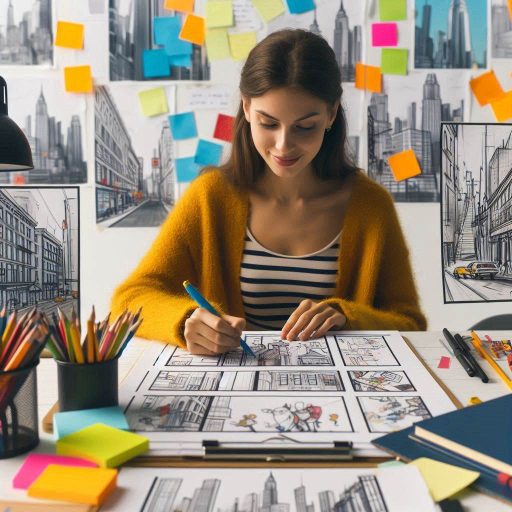Introduction
A storyboard is a visual tool that outlines scenes for films, advertisements, and animations.
It consists of sequential illustrations that convey the narrative and action.
Storyboards help creators visualize their ideas, making the production process smoother and more organized.
Storyboarding plays a critical role across various industries.
In film, it helps directors plan shots and understand pacing.
Advertisers use storyboards to map out commercials, ensuring they deliver a clear message.
In animation, storyboards guide the animation process, illustrating character movements and scene transitions.
This blog post will cover essential tips and tricks for beginners interested in storyboarding.
We will explore the key elements of a successful storyboard, such as composition and timing.
You’ll learn how to create dynamic scenes and develop engaging characters.
Additionally, we‘ll discuss common mistakes to avoid, ensuring a smoother workflow.
Finally, we will highlight tools and resources that can enhance your storyboarding skills.
By the end of this post, you will have a solid understanding of the storyboarding process and practical techniques to kickstart your journey.
With these insights, you‘ll be well-equipped to bring your visual storytelling ideas to life.
Importance of Storyboarding
Helps Visualize Ideas Before Production
Storyboarding is an essential step for beginners in animation.
It helps visualize ideas before moving to production.
Each panel serves as a visual representation of scenes and actions.
By sketching out these ideas, artists can see how the story unfolds.
This visualization aids in understanding pacing and timing.
Storyboards also allow creators to experiment with different concepts easily.
This practice leads to better storytelling and a more engaging final product.
Creating a storyboard provides a roadmap for the entire project.
Artists can break down scenes into manageable parts.
This breakdown enables a more organized approach to the animation process.
Beginners can explore various styles and compositions before committing to final designs.
Ultimately, storyboarding serves as a powerful tool for brainstorming and refining ideas.
Saves Time and Resources by Planning Ahead
Planning ahead with storyboards saves time and resources.
By outlining each scene, artists can identify what materials they need.
This foresight reduces unnecessary work during the production phase.
It helps avoid costly mistakes that could arise from poor planning.
When everyone knows the vision, production runs smoothly and efficiently.
Storyboards streamline the animation process by providing a clear guide.
Animators can follow the storyboard to create scenes accurately.
This structured approach minimizes the need for constant revisions.
Fewer revisions lead to a faster production timeline.
In turn, this efficiency often translates into lower costs.
Ensures Clear Communication Between Team Members
Clear communication is vital in any collaborative project.
Storyboarding facilitates this communication among team members.
A well-crafted storyboard provides a common reference point for everyone involved.
It ensures that artists, directors, and writers are aligned on the vision.
This shared understanding helps prevent misunderstandings during production.
Regularly reviewing the storyboard with the team fosters collaboration.
Everyone can provide input and suggest changes to improve the project.
This practice encourages a sense of ownership and teamwork.
By involving all members in the storyboarding process, creators can build stronger relationships.
These connections enhance the overall creative atmosphere and lead to better results.
Helps Identify Potential Issues Early On
Identifying potential issues early in the process is crucial for successful animation.
Storyboarding allows artists to spot inconsistencies or flaws before production begins.
Artists can evaluate whether the story flows smoothly or if changes are needed.
This early detection helps prevent major problems later on.
Storyboards help assess the feasibility of specific scenes.
Animators can determine if certain shots are too complex or time-consuming.
By addressing these challenges early, teams can adjust their plans accordingly.
This proactive approach leads to a more polished final product.
Beginners can also use storyboarding to refine their artistic skills.
By analyzing their work, they can identify areas for improvement.
This practice encourages growth and development in their craft.
Ultimately, storyboarding is a valuable learning tool that benefits all artists.
Storyboarding is a fundamental practice for beginners in animation.
It helps visualize ideas before production, saving time and resources.
Clear communication among team members is crucial for success, and storyboards facilitate this.
Identifying potential issues early on leads to a smoother production process.
By embracing storyboarding, beginners can enhance their storytelling abilities and improve their overall workflow.
This practice sets a strong foundation for future projects, helping artists create engaging narratives that captivate audiences.
With dedication and creativity, anyone can master the art of storyboarding.
Read: Breaking Down Iconic Movie Costumes
Basics of Storyboarding
Definition of Storyboard
A storyboard is a visual representation of a narrative.
It organizes scenes and illustrates how a story unfolds.
Storyboards help creators plan their projects before production begins.
They serve as a blueprint for filmmakers, animators, and other visual storytellers.
By breaking down a story into manageable parts, storyboards enhance clarity and communication among the creative team.
Artists use storyboards to visualize key moments in a narrative.
They can convey the pacing, flow, and emotional beats of a story.
This process allows creators to experiment with different ideas and approaches.
In essence, a storyboard helps bring a script to life through visuals.
Components of a Storyboard
A storyboard consists of several key components.
Each component plays a crucial role in storytelling.
Panels are the primary visual units, displaying individual scenes or moments.
Each panel typically includes illustrations or sketches of the action.
Shots indicate the camera angles and perspectives used in each scene.
Artists specify whether the shot is wide, medium, or close-up.
This information guides the viewer‘s focus and enhances storytelling.
Dialogue is another vital element of a storyboard.
It provides context for the characters’ actions and emotions.
Writers include the necessary lines of dialogue to accompany each scene.
This helps ensure that the visual and written elements work harmoniously together.
Additionally, artists often include notes and annotations.
These provide extra information about camera movements, sound effects, and transitions.
This level of detail is essential for effective communication with the production team.
Different Types of Storyboards
Storyboards come in various types, each serving specific purposes.
Thumbnail storyboards are small, rough sketches that capture the basic ideas of each scene.
They allow artists to quickly visualize concepts without getting bogged down in details.
Detailed storyboards provide a more comprehensive view of the narrative.
Artists create larger, more refined drawings that include character expressions and background elements.
This type of storyboard is useful for communicating complex scenes and actions.
Digital storyboards have gained popularity in recent years.
Artists use software like Storyboard Pro or Adobe Photoshop to create these storyboards.
Digital tools offer flexibility, allowing artists to easily edit and rearrange scenes.
This efficiency saves time and enhances collaboration within a creative team.
Other variations include animatics, which combine storyboards with audio and basic movement.
Animatics help visualize timing and pacing more effectively than static images alone.
They are especially useful during the pre-production phase of animated projects.
Choosing the right type of storyboard depends on the project’s needs and goals.
Artists should consider their audience and the level of detail required.
Each type offers unique advantages that can enhance the storytelling process.
In short, storyboarding is a fundamental skill for visual storytellers.
Understanding the definition of a storyboard and its components is essential.
Familiarity with different types of storyboards helps artists effectively convey their ideas.
By mastering these elements, beginners can significantly improve their storytelling abilities.
Read: Freelance vs. In-House Costume Design Jobs
Tips for Beginners
Start with Simple Sketches and Stick Figures
When beginning to storyboard, start with simple sketches.
Stick figures effectively represent characters and actions without overcomplicating the process.
These basic shapes allow you to focus on composition and layout.
Use quick sketches to capture the essence of each scene.
This method saves time and helps clarify your ideas.
Don‘t feel pressured to create perfect drawings; simplicity is key.
Stick figures convey movement and emotion clearly.
They allow you to visualize the flow of the story.
As you gain confidence, gradually add details to your sketches.
Focus on Key Moments and Transitions in the Story
Identify key moments that drive the story forward.
These moments are critical for audience engagement.
Concentrate on major plot points and emotional beats.
Each storyboard panel should highlight these pivotal scenes.
Think about how the audience will experience these moments.
Use transitions to connect scenes seamlessly.
Smooth transitions enhance the storytelling experience and maintain viewer interest.
Focus on pacing by ensuring each panel transitions logically.
Consider the emotional impact of each scene to enhance the narrative.
Use Different Colors or Labels to Differentiate Characters or Scenes
Color-coding your storyboards helps clarify your ideas.
Use different colors for various characters to keep track of their actions.
This method allows you to visualize interactions between characters easily.
You can also use colors to differentiate between scenes and settings.
Labeling each panel with specific details enhances understanding.
Include notes about character emotions, actions, and dialogue.
This practice aids in visualizing the story more effectively.
Color and labels can also help your team quickly grasp your vision.
This organization streamlines the revision process and fosters collaboration.
Don‘t Worry About Artistic Skills; Focus on Conveying the Idea
Many beginners worry about their artistic skills.
However, effective storyboarding is about conveying ideas, not creating masterpieces.
Focus on communicating your vision clearly through your sketches.
Remember, storyboards are primarily planning tools, not final artworks.
Emphasize clarity and simplicity in your drawings.
Use arrows and annotations to indicate movement and direction.
This approach helps others understand your intent without needing refined artistry.
Practice is crucial for developing your skills.
The more you sketch, the more comfortable you will become.
Set aside time each day for storyboarding practice.
Experiment with different styles and techniques to find what works best for you.
Seek feedback from peers to improve your storytelling skills.
Embrace constructive criticism to refine your work further.
Storyboarding for beginners can feel overwhelming, but it doesn’t have to be.
Start with simple sketches and stick figures to build your confidence.
Focus on key moments and transitions to maintain the narrative flow.
Use color and labels for clarity and organization.
Finally, prioritize conveying your ideas over artistic perfection.
With dedication and practice, you can master the storyboarding process.
These tips will help you embark on your storyboarding journey.
Embrace the simplicity of sketches and focus on storytelling.
Develop your skills gradually while seeking feedback from others.
By following these strategies, you‘ll create effective storyboards that communicate your vision clearly.
Happy storyboarding!
Read: Networking Events for Costume Designers
Tricks to Improve Storyboarding
Practice Regularly to Improve Storytelling Skills
Regular practice is essential for beginners in storyboarding.
Set aside time each day to sketch and refine your skills.
Focus on different aspects of storytelling, such as pacing and character development.
This consistent effort will enhance your understanding of visual narratives.
Start by creating short sequences.
Illustrate a simple scene or moment that tells a story in a few frames.
Challenge yourself to convey emotions and actions clearly.
As you practice, you will become more adept at visual storytelling.
Experiment with different genres and themes.
This diversity will broaden your storytelling range and inspire creativity.
Create storyboards for various scenarios, from action sequences to heartfelt moments.
Regular practice helps you find your unique voice as an artist.
Track your progress over time.
Review your older work and note improvements and areas for growth.
This reflection can motivate you to keep practicing.
Celebrate your achievements, no matter how small, to stay inspired.
Study Existing Storyboards in Films or Animation
Studying existing storyboards can provide valuable insights into effective storytelling.
Analyze storyboards from your favorite films or animated series.
Observe how professional artists convey movement, emotion, and pacing.
Look for online resources that showcase storyboard breakdowns.
Many filmmakers and animators share their work on platforms like YouTube and Vimeo.
These breakdowns often include commentary, explaining their creative choices.
Learn from their techniques and incorporate them into your practice.
Books about storyboarding and visual storytelling can also be beneficial.
They often include examples and tips from industry professionals.
Familiarize yourself with different storytelling methods used in various genres.
Consider attending film screenings or animation festivals.
Many events feature discussions with artists who share their storyboarding processes.
Engage in these conversations to gain fresh perspectives and techniques.
Experiment with Different Styles and Techniques
Experimentation is key to finding your unique style in storyboarding.
Try various techniques, such as digital and traditional methods.
Explore different software tools to discover what works best for you.
Vary your visual style by mimicking the aesthetics of different artists.
This can help you understand how different approaches influence storytelling.
Experimenting with color palettes, line work, and composition will enhance your versatility.
Try creating storyboards in different formats.
Some projects might require detailed panels, while others need quick sketches.
Adapting your style based on the project helps you become a more flexible artist.
Set challenges for yourself, such as creating a storyboard in one hour.
These timed exercises encourage you to think quickly and creatively.
Experimentation fosters growth and helps you develop new skills.
Collaborate with Others for Feedback and Ideas
Collaboration can significantly enhance your storyboarding skills.
Working with others allows you to gain different perspectives.
Seek feedback from fellow artists or friends who share your interests.
Join online forums or local art groups to connect with other storyboard artists.
Share your work and ask for constructive criticism.
Embrace feedback as an opportunity to grow and improve.
Participate in collaborative projects, such as short films or animations.
Working with a team encourages creative exchange and inspires fresh ideas.
Collaboration also helps you learn how to incorporate others’ visions into your storyboarding.
Attend workshops or classes to meet other aspiring artists.
Engaging in group discussions can spark new ideas and techniques.
These interactions can also lead to lasting friendships within the artistic community.
Beginners in storyboarding should practice regularly and study existing work.
Experimenting with styles and collaborating with others enhances skills and creativity.
By embracing these tips and tricks, aspiring storyboard artists will develop their storytelling abilities and find their unique artistic voice.
Read: Building a Portfolio for Costume Design
Transform Your Career Today
Unlock a personalized career strategy that drives real results. Get tailored advice and a roadmap designed just for you.
Start Now
Tools and Software for Storyboarding
Traditional Tools Like Paper, Pencils, and Markers
Starting with traditional tools can help beginners understand the basics of storyboarding.
Paper, pencils, and markers are accessible and affordable.
Using these tools encourages artists to focus on composition and visual storytelling.
Sketching by hand allows for a more organic creative process.
Begin by drawing simple panels to visualize scenes.
Break the story into manageable chunks and sketch each one.
Use pencils for initial sketches to easily make adjustments.
Once satisfied, go over the sketches with markers for emphasis.
This process helps artists develop their unique style over time.
Traditional tools also promote spontaneity and creativity.
You can quickly jot down ideas whenever inspiration strikes.
The tactile nature of paper and pencil often sparks new concepts.
Additionally, working by hand can help you better understand pacing and transitions.
Consider using various types of paper for different effects.
For example, thicker paper is suitable for detailed illustrations, while sketch paper works well for rough drafts.
Experimenting with different markers can also enhance your drawings.
Each tool contributes to the overall quality of your storyboard.
Digital Tools Like Adobe Photoshop, Storyboarder, or Procreate
Digital tools have transformed the storyboarding process for beginners.
Programs like Adobe Photoshop offer powerful features for creating detailed boards.
You can easily manipulate images, add colors, and create layers.
Photoshop‘s flexibility allows for quick adjustments and refinements.
Storyboarder is specifically designed for storyboard artists.
This user-friendly software offers templates, easy sketching options, and drag-and-drop functionality.
You can create panels and organize your story quickly.
Additionally, Storyboarder allows for easy exporting to share your work.
Procreate has gained popularity among artists for its intuitive interface.
This app provides a wide range of brushes and tools for drawing.
You can work on an iPad, allowing for portability and convenience.
Procreate‘s animation features enable you to visualize movement and transitions effectively.
Using digital tools enhances collaboration opportunities.
You can easily share your work with others for feedback and revisions.
These programs often include features for commenting, making it easier to communicate ideas.
Digital tools can streamline the overall workflow, allowing for faster production.
Online Platforms for Collaboration and Sharing Storyboards
Online platforms play a crucial role in the storyboarding process for beginners.
They facilitate collaboration and sharing with fellow artists and team members.
Websites like Dropbox, Google Drive, and OneDrive allow easy file sharing and storage.
You can upload your storyboards for others to review and comment on.
Additionally, platforms like Trello and Asana help manage projects and track progress.
You can create boards for different scenes and assign tasks to collaborators.
This organization streamlines communication and keeps everyone updated.
Online platforms encourage teamwork and foster creativity among artists.
Forums and social media groups also provide valuable networking opportunities.
Joining communities focused on storyboarding can lead to insightful feedback.
Websites like Behance and ArtStation allow you to showcase your work to a broader audience.
Engaging with these platforms can enhance your visibility in the industry.
Consider using dedicated storyboard sharing sites like Storyboard That.
These platforms allow you to create, share, and collaborate on storyboards easily.
You can access a library of assets, making the creation process more efficient.
These online tools can significantly improve your storyboarding skills.
In summary, beginners can benefit from various tools and platforms in storyboarding.
Traditional tools like paper and markers encourage hands-on creativity.
Digital tools such as Adobe Photoshop and Storyboarder streamline the process.
Online platforms facilitate collaboration and sharing, fostering a supportive community.
By exploring these resources, beginners can develop their storyboarding skills and effectively convey their visual stories.
Common Mistakes to Avoid
Overcomplicating the Storyboard with Unnecessary Details
When starting with storyboarding, simplicity is key.
Avoid overcomplicating your storyboard with excessive details.
Focus on the essential elements that drive your story forward.
Intricate backgrounds and minute character expressions can distract from the main narrative.
Use clear visuals to convey action and emotion without clutter.
Stick figures or basic shapes often suffice in early drafts.
Your goal is to communicate ideas, not create final artwork.
Consider the overall flow of your storyboard.
Each frame should serve a purpose and move the story along.
If a detail does not enhance the narrative, remove it.
Limit the number of frames to keep the story concise.
Too many frames can confuse viewers and dilute your message.
Maintain clarity by highlighting key moments that matter most.
Review your storyboard with fresh eyes to identify unnecessary elements.
Ask yourself if each detail contributes meaningfully to the narrative.
This practice fosters a more focused and effective storyboard.
Skipping the Planning Phase and Jumping into Production
Jumping straight into production without proper planning is a common pitfall.
Take time to outline your story before creating a storyboard.
This outline serves as a roadmap for your visuals.
Planning allows you to establish character arcs, plot points, and pacing.
Without a clear plan, you may find yourself lost during production.
Create a shot list to identify key scenes and transitions.
This list helps you visualize the flow of your story.
A well-thought-out plan saves time and minimizes frustration later.
Involve your team in the planning phase.
Gathering input from collaborators ensures everyone is on the same page.
This teamwork can enhance creativity and foster a shared vision.
Utilizing tools like mind maps or storyboards in the planning stage can be beneficial.
These tools help you organize thoughts and visualize ideas effectively.
Taking the time to plan will ultimately lead to a more successful production process.
Proper planning sets a solid foundation for your storyboard and project.
Ignoring Feedback from Team Members or Clients
Feedback is crucial for refining your storyboard.
Ignoring input from team members or clients can hinder your growth as an artist.
Constructive criticism provides valuable insights that can enhance your work.
Encourage an open dialogue during the storyboard review process.
Create a safe space where team members feel comfortable sharing their thoughts.
Listen actively and consider their suggestions seriously.
Be willing to make changes based on feedback.
This flexibility shows your commitment to delivering the best project possible.
It also demonstrates your ability to collaborate effectively.
Seek feedback early in the process to identify issues sooner.
This approach allows for adjustments before moving into production.
The sooner you address concerns, the smoother the production will run.
Remember, feedback is not a personal attack; it is a tool for improvement.
Embrace the opportunity to learn and grow through collaboration.
Not Revising or Updating the Storyboard as Needed
Revising your storyboard is an essential part of the creative process.
Many beginners neglect this crucial step and miss valuable opportunities for improvement.
Revisions allow you to refine ideas and strengthen your narrative.
After receiving feedback, take the time to make necessary adjustments.
Address any concerns raised by your team or clients.
Updating your storyboard can lead to a more polished final product.
Schedule regular review sessions throughout the production phase.
These check-ins ensure that your storyboard remains aligned with the project’s vision.
Adjustments can prevent major issues later in the process.
Document changes clearly to keep everyone informed.
This transparency helps maintain a cohesive vision among team members.
As your project evolves, your storyboard should adapt accordingly.
Embrace change as a natural part of the creative process.
Regularly revising and updating your storyboard leads to better storytelling and a more successful project overall.
Learn More: Understanding Printing Techniques for Packaging
Conclusion
Storyboarding is vital for beginners in animation and film.
It helps you visualize your narrative before diving into production.
Creating storyboards allows you to explore character actions, settings, and scene transitions.
This practice enhances your storytelling skills and clarifies your vision.
Regular practice is essential for improvement.
Sketching daily or weekly can help refine your techniques and build confidence.
Experiment with different styles, such as thumbnail sketches or digital storyboarding tools, to discover what works best for you.
Each technique offers unique benefits that can enhance your storytelling.
Don‘t hesitate to seek feedback from peers or mentors.
Sharing your work with others can provide valuable insights and constructive criticism.
Collaborating with fellow artists can introduce new ideas and perspectives, further enriching your storytelling approach.
Engaging in group projects can also simulate real-world production environments.
Remember, the key to mastering storyboarding lies in exploration and practice.
Embrace the learning process, and don‘t be afraid to make mistakes.
Use each experience to grow and develop your unique voice as a storyteller.
By actively seeking feedback and experimenting with techniques, you will build a solid foundation for your animation journey.
Keep pushing your creative boundaries, and watch your skills flourish.




